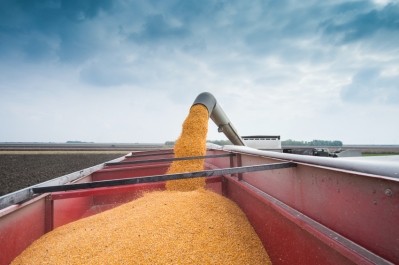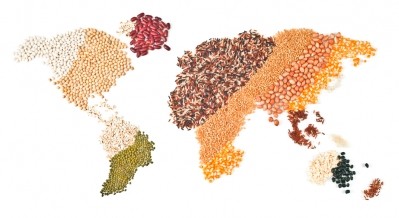Growing supplies will keep pressure on prices, USDA predicts US soy crop record

The USDA updated its predictions and information for US feed crop production in the World Agricultural Supply and Demand Estimate (WASDE) report released Tuesday.
The current improvement of almost $0.50 in soybeans and $0.10 in corn futures prices may only be for the short term said Scott Brown, agricultural extension economist with the University of Missouri.
“This is the first look at what the USDA is saying about 2016/17 crop,” he told FeedNavigator. “[In terms of] the global production of corn and soybeans, we’re going to be at a record in soybean and slightly shy of a record in corn for 2016/17, rivaling 2014/15.”
“Short term the market has been more positive than we thought pre-report,” he said. “But [farmers] planted a lot of acres around the world and growing supplies will keep pressure on prices.”
Corn and soy
US corn production for 2016/17 is set at 14.4bn bushels, an increase of 829m from 2015/16 and 214m bushels above the record set in 2014/15, said the USDA.
Corn yield per acre is predicted to be down, but supplies for 2016/17 are set at a record 16.3bn covering a reduction in sorghum, barley, and oats, said the agency.
Corn use is set to increase 4% to a record 14.1bn bushels, said the agency. Feed and residual use for 2016/17 is projected 300 million bushels higher with higher production, lower prices, and further expansion in animal numbers in 2016/17, it reported.
“We are getting some bump in corn markets today, we’re currently sitting around $0.10 [up] in the future markets,” said Brown.
But, the projected season-average farm price for corn was set at a range of $3.05 to $3.65 a bushel, a midpoint drop of about $0.25 from what was set for 2015/16, said the USDA.
“You have to go back a few years to get to that low a price,” said Brown.
At this point it is hard to predict what prices may be, he said, as much depends on how the crop being planted develops and what weather occurs.
Weather remains the factor to watch, he said. The supplies of feed crops will likely have the greatest influence on price rather than looking for pressure from demand.
“The soybean ending stocks being lowered 95m bushels have given soybean stocks the increase we’ve seen,” said Brown.
Soybean production has been set at 3.8bn bushels, a drop from the 2015 crop based on fewer acres being planted and decline in yield, said the USDA. Supplies for 2016/17 are expected to increase to 4.2bn bushels.
Soybean crush also has been increased up to 1.91bn bushels, the agency said.
The season average price range for soybeans has been forecast at $8.35 to $9.85, and the range for soybean meal has been predicted at $300 to $340 a short ton.
Wheat
“I don’t think we got nearly the surprises in wheat that we got in corn and soybeans,” said Brown. However, the global crop may continue to apply pressure to wheat prices, he added.
Supplies of US wheat are expected to increase by 6% for 2016/17, said the USDA. The increase is based on higher beginning stocks and imports as total wheat production is projected to be down 3%.
The decline was based on a reduction in acres planted that is expected to offset improved yield, the agency said. The all wheat yield is projected at 46.7 bushels per acre, up 7% from the previous year, it added.
Forecasts for winter wheat in 2016/17 include increased production stemming from higher yields, the agency reported.
Winter wheat has benefited from excellent spring growing conditions and yields are projected higher for hard red winter, soft red winter, and white winter, said the USDA. Spring wheat and durum production for 2016/17 is projected to decline 16% on lower area, as well as a return to trend yield, which is below last year’s level, forecast the US agency.
Wheat use for 2016/17 predicted to increase by 7% from 2015/16 owing to improved exports along with feed and residual use and use in food, the agency said. Feed and residual use is expected to increase by about 30m bushels.
Ending stocks in the US are expected to increase 51m bushels from 2015/16 reaching levels last seen in 1987/88, reported the USDA. The all wheat season average farm price is projected at $3.70 to $4.50 per bushel; the mid-point of this range is the lowest in 11 years, it added.
Global snapshot and trade details
“China matters in some of this especially in corn,” said Brown. The report indicates an increase in Chinese corn use, and there could be challenges if that doesn’t happen, he added.
The global supply of corn is set to increase to 1.01bn tons, said the USDA, while corn consumption rises to 1.01bn tons. Consumption in China is expected to be up 9.5m tons, it added.
Corn exports for 2016/17 are expected to increase both in the US and globally but there could be a decline in global imports, the agency said. But, world ending stocks are expected to drop slightly.
Soybean meal exports are expected to increase from 2015/16, said the agency, and soybean exports are also set to improve. The US soybean export share is projected at 37%, up slightly from 2015/16 and near the 5-year average, predicted the agency.
Global soybean production is forecast to rise by 8.3m tons stemming from India, Brazil, Ukraine and Argentina, reported the USDA. However, an expected crush increase of 2.3% means oilseed ending stocks are expected to be down 9.5% from 2015/16.
Wheat exports are expected to be at 875m bushels, and increase of 95m bushels from 2015/16, but still below average based on large supplies in other countries, said the USDA.
Global stocks of wheat are expected to see a 2% increase, reported the agency, and total production is predicted to be 727m tons the second largest total recorded.
Global import demand for 2016/17 is down from last year’s record, but still very large, it noted. Meanwhile, global ending stocks for 2016/17 are projected at a record 257.3m tons, up 14.4, from 2015/16.













